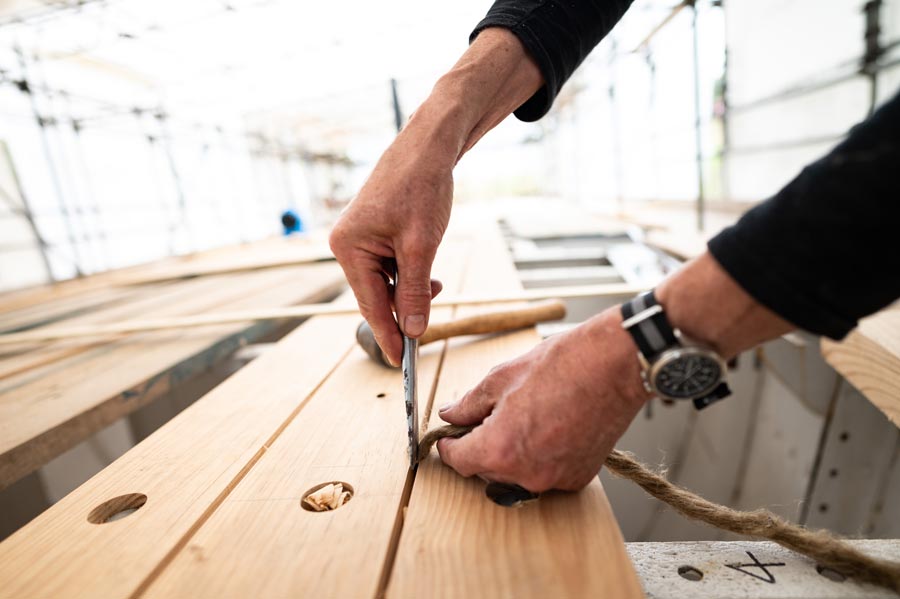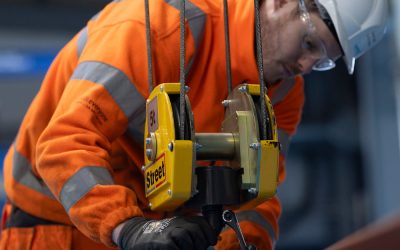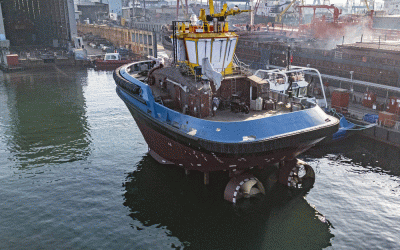Is traditional wooden boatbuilding becoming a lost art?
(images: Robin Zahler)
What do harp-making, boot-making and slating have in common? The answer is that all three skills have made it onto Heritage Crafts’ Red List of Endangered Crafts, which ranks heritage craft skills at risk of dying out before they can be passed on to the next generation. The Red List includes skills considered ‘Extinct’ (for example, cricket ball-making), ‘Critically Endangered’ (such as flute-making and industrial pottery), ‘Endangered’ (including iron founding and rope-making) and ‘Currently Viable’.
Alongside these craft skills, though, October 2022 saw Heritage Crafts and the Wooden Boat Builders Trade Association (WBTA) co-host the Traditional Wooden Boat Building Skills Symposium in Bristol, to ask the question: are wooden boatbuilding skills at risk of becoming an ‘endangered species’ in the UK?
Mary Lewis, endangered crafts manager at Heritage Crafts, explains: “Attracting young people to traditional wooden boatbuilding is only part of the problem; there is also a lack of support and funding for those who want to develop these skills.” This puts the onus on those boatbuilders with bigger budgets to offer the necessary apprenticeships and courses to students keen to pick up these skills. As with everything these days, though, the more immediately financially rewarding and ‘in demand’ projects will always be prioritised.

This has been the experience for Stephen Beresford, senior conservation boatbuilder at Windermere Jetty Museum and founder of the Good Wood Boat Company. An experienced boatbuilder, chartered engineer and maritime heritage consultant, Beresford is in charge of all aspects of vessel conservation and restoration at the museum, which opened its doors to the public in 2019. The museum stores, floats and operates various wooden boats built between 1780-1983, as well as exhibiting them on land and in galleries.
“Modern wooden boatbuilding techniques are a lot more similar to boatbuilding with GRP,” Beresford tells Ship & Boat International. “Rather than using solid wood only for each component, the builders will order western red cedar, or yellow cedar, provided in a ‘strip planking’ form, with each plank about a square inch [645mm2] in section.”
These strip planks have spindle-moulded male and female edges and are held together in an epoxy sheath, providing an aesthetically pleasing, classic wood finish. Additionally, wood can be incorporated into other composite builds involving carbon fibre or fibreglass: using wood for fitting out, for example. Rather than the traditional method of ‘lofting’ (scaling up the vessel plans to full size and drawing manually, unaided by CAD/CAM), modern wooden boat components are typically delivered to the builder in CNC router-cut kits – this technology acting as a sort of ‘middleman’ in the process, and undoubtedly speeding up the production process: useful when a boatbuilder’s lucky enough to encounter high demand for a boat type.
While CNC-cut boat components are produced with the utmost precision, overreliance on this technology does put traditional lofting skills at risk, Beresford explains. Another potentially at-risk skill is the capacity to fully understand and analyse trees and forestry: a crucial factor when it comes to selecting and processing timber. “It’s important that the grains and fibres of the timber run in particular orientations around the boat’s components,” he says. “This is knowledge that a naval architect sitting behind an electronic screen, and with access to CAD/CAM packages, may not necessarily have.”
Other skills that may be at risk include caulking, rigging and steam bending in large scale. Another crucial skillset – the loss of which could have serious repercussion for the UK’s maritime heritage – is that of wooden ship repair, renovation and maintenance. Two recent examples of the latter include the restoration work carried out on the iconic HMS Victory in Portsmouth and HMS Trincomalee in Hartlepool. This is because applying modern repair techniques to older wooden boats can be disastrous. “Sometimes we accept older boats at the museum and think, ‘oh no’…we can see that someone has tried to repair the boat but has damaged it instead,” Beresford continues. “We’ve seen cases where inexperienced repairers have used polyester or epoxy resins to fix a leak on board a traditionally built wooden boat. As a result, the water has got behind the repair and has rotted the wood away.”
Perhaps one of the biggest roadblocks to the preservation of traditional wooden boatbuilding skills is the overall cost of production – builders simply can’t subsist on vanity projects. Beresford challenges the notion that traditional wooden construction methods exist in isolation from more modern techniques, commenting: “Most people learn boatbuilding using wood: it’s foundational for understanding other materials and techniques. Also, techniques such as traditional lofting have their place in understanding hull design and shape and the relationships to building.”
However, traditionally crafted newbuilds necessitate significant labour and overheads, sometimes with little financial reward. Beresford points out that a builder can spend a considerable amount of time templating, photographing and making notes on a new design, to retain this knowledge for repeat orders – “you never forget, but you can get a little rusty between orders”, he says – only for the initial, painstaking order to prove a one-off. Additionally, a lack of repeat orders makes it difficult to justify hiring contractors or new staff to pitch in with projects.
At the end of the Bristol symposium, it was decided that more research was needed before making a decision on whether to categorise traditional wooden boatbuilding as endangered. Heritage Crafts is now following up on the event by conducting a survey of UK boatbuilders (set to run until the end of January 2023) to gather accurate data and valuable feedback that will inform its decision as to whether this skillset should be considered for inclusion on the Red List’s ‘Endangered’ section – a decision Heritage Crafts expects to make in May. Lewis explains that the survey was deemed necessary as “there is no clear data on how many traditional wooden boatbuilders are working in the UK”.
(For the full in-depth article, see Ship & Boat International January/February 2023. The WBTA and Heritage Crafts survey can be accessed at: https://forms.gle/TEtLz7tJkytqbNNG7 and the closing date is 31 January 2023)




